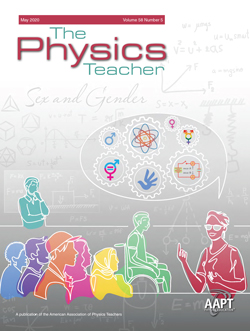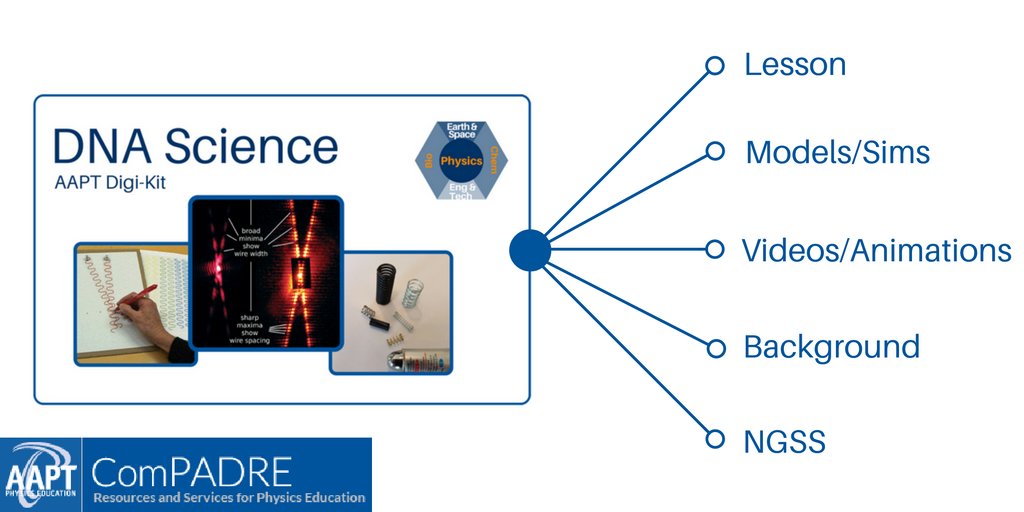The Physics Teacher
Volume 58 Issue 5
May 2020
This month's cover portrays a physics student sharing with the class her group’s perspective on the topic of the day. This vibrant glimpse into a modern physics classroom was created by Jen Geanakos especially for this collection of articles on “Sex, Gender, and Physics Teaching” starting on page 294 and continuing through the fall of 2020.
Since August 1, 2014, the submission process for articles for The Physics Teacher has required authors to submit their article and cover letter at this website: http:www.editorialexpress.com/tpt. Starting June 10, 2020, the submission process for articles for The Physics Teacher will change. On or after June 10th, authors submit their article and cover letter at this website: http://tpt.peerx-press.org/.
Columns
And the Survey Says..., Figuring Physics, iPhysicsLabs Little Gems, Physics Challenge for Teachers and Students, Fermi Questions, Talkin' Physics, Technology In The Classroom, Visual Physics, and Websights.
Editorial
A second call-and-RESPONSE! by Geraldine L. Cochran and Gary D. White, Co-Editors for the Special Collection on “Sex, Gender, and Physics Teaching. DOI: 10.1119/1.5145516
Papers
Physics from an Underrepresented Lens: What I Wish Others Knew by Sofia Herrera, Ikram A. Mohamed and Abigail R. Daane. DOI: 10.1119/1.5145517
Why Are There So Few Women in Physics? Reflections on the Experiences of Two Women by Danny Doucette and Chandralekha Singh. DOI: 10.1119/1.5145518
The Elephant in the (Physics Class) Room: Discussing Gender Inequality in Our Class by Olivia Eickerman and Moses Rifkin. DOI: 10.1119/1.5145520
Chasing the Aurora Borealis by Richard P. Hechter. DOI: 10.1119/1.5145521
Is It Simple to Explain Simple Experiments?: An Unusual Version of the Magdeburg Experiment with a Kitchen Blender Dragia Trifonov Ivanov and Stefan Nikolaev Nikolov. DOI: /10.1119/1.5145522
Supporting Inclusive Teaching in Introductory College Physics by Stephen Getty, Natalie Gosnell, Barbara Whitten and Joseph Taylor. DOI: 10.1119/1.5145523
Simple Steps to Promote Classroom Engagement and Inclusion: A Report from the Field by Roger G. Tobin. DOI: 10.1119/1.5145524
Physics Textbooks from 1960–2016: A History of Gender and Racial Bias by Timothy M. Lawlor and Timothy Niiler. DOI: 10.1119/1.5145525
Networks of Support: Investigating a Counterspace that Provides Identity Resources for Minoritized Students in Post-Secondary Physics by Allison J. Gonsalves and Hannah R. Chestnutt. DOI: 10.1119/1.5145526
Thank You to Our Referees!: July 19, 2019 – March 30, 2020. DOI: 10.1119/1.5145527
Magnetic Forces Between a Magnet and a Solenoid by Munho Kwon, Joongwoo Jung, Taehun Jang and Sangho Sohn. DOI: 10.1119/1.5145528
Being a Token Black Female Faculty Member in Physics: Exploring Research on Gendered Racism, Identity Shifting as a Coping Strategy, and Inclusivity in Physics by Danielle Dickens, Maria Jones and Naomi Hall. DOI: 10.1119/1.5145529
Determining the Acceleration Due to Gravity and Friction Using the Ticker Tape Timer Method by Ethan Fontana, Chuck Yeung and Jonathan C. Hall. DOI: 10.1119/1.5145530
Dry Friction Camouflaged in Viscous Drag by Dejan M. Djokić. DOI: 10.1119/1.5145531
Lessons from Research Exploring the Underrepresentation of Women in Physics by Chris Gosling and Allison J. Gonsalves. DOI: 10.1119/1.5145532
Gender & Self-Efficacy: A Call to Physics Educators by Rachel Henderson, Vashti Sawtelle and Jayson Micheal Nissen. DOI: 10.1119/1.5145533
The International Conferences for Women in Physics by Laura McCullough and Jessica Esquivel. DOI: 10.1119/1.5145534
Changing Culture and Climate to Prevent Sexual Harassment in the Physics Educational Setting by Alexis V. Knaub, Steven J. Maier and Lin Ding. DOI: 10.1119/1.5145535
The Search for Exoplanets: A Capstone Project in Service Learning and Outreach by Avery Archer, David Sederberg, Guna Kondapaneni and Philip Sands. DOI: 10.1119/1.5145536
Constructing a model ground-effect vehicle by Doug Stith. DOI: 10.1119/1.5145540
Race and Physics Teaching Collection Resource
DNA Science Lesson & Digi-Kit
Inspired by an article from The Physics Teacher, this multidisciplinary lesson and digital resource collection is based on How Rosalind Franklin Discovered the Helical Structure of DNA: Experiments in Diffraction (Braun, Tierney, & Schmitzer, 2011). Click the image to access this resource.



